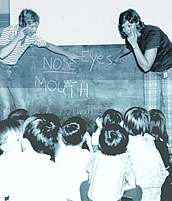
| HOME |
| READ |
| FIND |
| about |
| teach |
| help |
| reproduction |
| contact us |
| Additional Reading - Bibliography on Educational Conditions |
 |
| READ
about |
| Definition of Terms |
| Key
Topics |
| Ethnic Groups |
| Additional Reading |
| Escape & Survival |
| Cultural Practices |
| Social Issues |
| Economic Experiences |
| Educational Conditions |
| Political Issues |
Caplan, Nathan S., Choy, Marcella H. and Whitmore, John K. (1991). Children of the boat people: A study of educational success. Ann Arbor: University of Michigan Press. Chang, Paokong John and Jerry Rosiek. (2003). Anti-colonialist antinomies in a biology lesson: A sonata-form case study of cultural conflict in a science classroom. Curriculum Inquiry 33(2), 251- 290. Chuong, Chung Hoang. (1999). Vietnamese American students: Between the pressure to succeed and the pressure to change. Clara C. Park and Marilyn Mei-Ying Chi, (Eds), Asian-American education: Prospects and challenges. (pp. 183-00). Westport, CT: Bergin & Garvey. DeVoe, Pamela A. (1994). Refugees in an educational setting: A cross-cultural model of success. In Linda A. Camino & Ruth M. Krufeld (Eds.), Reconstructing lives, recapturing meaning (pp. 235- 249). Washington, D.C.: Gordon and Breach. Inoway-Ronnie, Eden. (1998). High/scope in Head Start programs serving Southeast Asian immigrant and refugee children and their families: Lessons from an ethnographic study. In Jeanne Ellsworth and Lynda J. Ames (Eds.), Critical perspectives on Project Head Start: Revisioning the hope and challenge. (pp. 167- 199). Albany: State University of New York Press. Kiang, Peter N. (1995). Bicultural strengths and struggles of Southeast Asian Americans in school. In Antonia Darder (Ed.), Culture and difference: Critical perspectives on the bicultural experience in the United States. (pp. 201-225). Westport, CT: Bergin & Garvey. Kiang, Peter N. (1996). Persistence stories and survival strategies of Cambodian Americans in college. Journal of Narrative and Life History, 6(1), 39-64. Lee, Stacey J. (2005). Up against whiteness: Race, school, and immigrant youth. New York: Teachers College Press. McGinnis, Theresa. (2007). “Khmer Pride”: Being and becoming Khmer American in an urban migrant education program. Journal of Southeast Asian American Education & Advancement 2. http://129.115.51.210/index.php/JSAAEA/article/view/8/12 Saito, Lynne Tsuboi. (2002). Ethnic identity and motivation: socio-cultural factors in the educational achievement of Vietnamese American students. New York: LFB Scholarly Pub. Smith Hefner, Nancy J. (1990). Language and identity in the education of Boston area Khmer. Anthropology and Educational Quarterly, 21(3), 250-268. Thao, Yer J. (2003). Empowering Mong students: Home and school factors. The Urban Review 35(1), 25- 42. Vietnamese Americans: Lessons in American history: An interdisciplinary curriculum and resource guide. (2004). Vietnamese American Curriculum Project Committee, Orange County Asian and Pacific Islander Community Alliance. 2nd ed. Garden Grove, CA: The Alliance. Um, Khatharya. (2003). A dream denied: Educational experiences of Southeast Asian American youth: Issues and recommendations. Washington D.C.: Southeast Asia Resource Center. Walker Moffat, Wendy. (1995). The other side of the Asian American success story. San Francisco: Jossey-Bass. Wright, Wayne. (2004). What English-only really means: A study of the implementation of California language policy with Cambodian American students. Bilingual Education and Bilingualism 7(1), 1-23. |